926167
Chitosan glycidyl methacrylate
Degree of methacrylation ~20%
Synonym(s):
Chitosan acrylate, Chitosan methacrylate, Methacrylate grafted chitosan, Methyl methacrylate modified chitosan
Sign Into View Organizational & Contract Pricing
All Photos(1)
About This Item
Linear Formula:
(C13H21NO7)n (C8H13NO5)m
UNSPSC Code:
12352201
NACRES:
NA.23
Recommended Products
Quality Level
storage temp.
2-8°C
SMILES string
CO[C@H]1[C@@H](O)[C@@H](N)[C@H](O[C@H]2[C@@H](O)[C@@H](NC(C)=O)[C@H](C)O[C@@H]2CO)O[C@@H]1COCC(O)COC(C(C)=C)=O
Application
The unique physicochemical properties offer chitosan great potential in a range of biomedical applications such as tissue engineering, drug delivery vehicles, and enzyme immobilization for biosensing. Methacrylate functionalized chitosan is thermo/photo cross-linkable and used as a precursor for the fabrication of hydrogels in a wide range of biomedical applications including tissue engineering, 3D bioprinting, and drug and gene delivery. Chitosan-based material also has mucoadhesive properties and hence widely used in transmucosal therapeutics delivery.
Storage Class Code
11 - Combustible Solids
WGK
WGK 3
Flash Point(F)
Not applicable
Flash Point(C)
Not applicable
Certificates of Analysis (COA)
Search for Certificates of Analysis (COA) by entering the products Lot/Batch Number. Lot and Batch Numbers can be found on a product’s label following the words ‘Lot’ or ‘Batch’.
Already Own This Product?
Find documentation for the products that you have recently purchased in the Document Library.
Shefali Jaiswal et al.
Carbohydrate polymers, 211, 109-117 (2019-03-03)
A methyl methacrylate (MMA) modified chitosan (CS) conjugate (CSMMA) has been synthesized by a green method via Michael addition reaction between CS and MMA in ethanol. The synthesized conjugate was characterized by FT-IR, 1H NMR, X-ray diffraction spectrometry and SEM
Farnoosh Pahlevanzadeh et al.
Materials (Basel, Switzerland), 13(11) (2020-06-18)
Chitosan (CS) has gained particular attention in biomedical applications due to its biocompatibility, antibacterial feature, and biodegradability. Hence, many studies have focused on the manufacturing of CS films, scaffolds, particulate, and inks via different production methods. Nowadays, with the possibility
Md Minhajul Islam et al.
Bioactive materials, 5(1), 164-183 (2020-02-23)
In recent years, there have been increasingly rapid advances of using bioactive materials in tissue engineering applications. Bioactive materials constitute many different structures based upon ceramic, metallic or polymeric materials, and can elicit specific tissue responses. However, most of them
Chandra M Valmikinathan et al.
Soft matter, 8(6), 1964-1976 (2012-02-14)
Hydrogel based scaffolds for neural tissue engineering can provide appropriate physico-chemical and mechanical properties to support neurite extension and facilitate transplantation of cells by acting as 'cell delivery vehicles'. Specifically, in situ gelling systems such as photocrosslinkable hydrogels can potentially
Oluwadamilola M Kolawole et al.
International journal of pharmaceutics, 550(1-2), 123-129 (2018-08-22)
Chitosan is a cationic polysaccharide that exhibits mucoadhesive properties which allow it to adhere to mucosal tissues. In this work, we explored chemical modification of chitosan through its reaction with methacrylic anhydride to synthesise methacrylated derivative with the aim to
Our team of scientists has experience in all areas of research including Life Science, Material Science, Chemical Synthesis, Chromatography, Analytical and many others.
Contact Technical Service






